
An arteriovenous malformation (AVM) is a rare condition in which an artery, typically a coronary artery, becomes enlarged and obstructed by a large clot. Blood flowing through the artery is obstructed, causing decreased blood flow. The artery wall itself has a thickened lining, called atherosclerotic plaques. The resulting blockage can lead to stroke, heart attack, or other complications. This type of blockage occurs when there is excessive cholesterol build up, clogging of the arteries, or some other health issue.
Arterioles and capillaries that carry oxygenated blood from the heart out to the body's tissues. Arteriosclerosis is an example of atherosclerotic plaques. In this case, the blockage is caused by plaque buildup, usually due to high blood pressure.
Arterioles and capillaries are involved in the exchange of oxygen and carbon dioxide within the body. When these structures become clogged with plaque, the blood cannot flow properly and the flow of oxygen to and from the organs is reduced. When this occurs, there is a lack of oxygen and carbon dioxide in the blood. When the arteries are affected, the heart cannot pump sufficient blood to the body's vital organs.
The process of exchanging oxygen and carbon dioxide is called ventilation and is completed by the arterioles. When a patient suffers from AVM, his blood is not able to reach the vital organs and is instead forced into the lungs, where it is then pressurized with carbon dioxide. This causes the heart to pump less blood and exert less force on the muscles of the body. Since there is less oxygen supply, it takes longer to get the required amount to every organ in the body.
Arterio Venous is not a new term, but it has only recently been recognized as a specific disorder and is now known as AVM. Many doctors and scientists are researching ways to cure AVM and make it less common.
Some treatments are available that reduce the chances of AVM and in some cases, they can prevent AVM from occurring. In addition, other forms of treatment are available that can help to improve circulation.
The most common types of treatment used include surgery and electrical stimulation

Some people think that surgery may be the best way to treat AVMs, and to some extent they are correct. However, this is a serious condition, so you need to consult your doctor. It is also true that surgery does nothing to correct the venous artery. Surgery will remove the blockage in the artery wall but will not correct the underlying cause of the blockage. Some of the causes of the problem may not show up after surgery, so you may have to wait until the blockage goes away on its own before you can get the right treatment to stop it.
Electrical stimulation is also a common form of AVM treatment, although it is somewhat controversial. Electrotherapy can help improve blood circulation in the body, but it doesn't actually repair the walls of the arteries and does nothing to prevent them from re-acting. The most common form of electrical stimulation involves the use of electrodes to deliver a weak electrical current to the walls of an artery to stimulate blood flow.
You have to be careful if you decide to try electrotherapy because it doesn't work for everyone. Some patients cannot tolerate the procedure, especially those who are pregnant or have health problems. In some cases, it can also cause an allergic reaction in the patient.
There are other forms of treatment for AVMs, including medication and surgery. If the problem persists or worsens, you may need to undergo more invasive procedures such as angioplasty or heart valves or endocardial infarction.
To sum up, AVM is not a new term, but it is only recently recognized as a specific condition and is called arteriovenous malformation. You should always talk to your doctor if you suspect you have AVM. He or she will help you decide if AVM is the cause of your symptoms and if there are any other underlying medical problems that may be causing it.